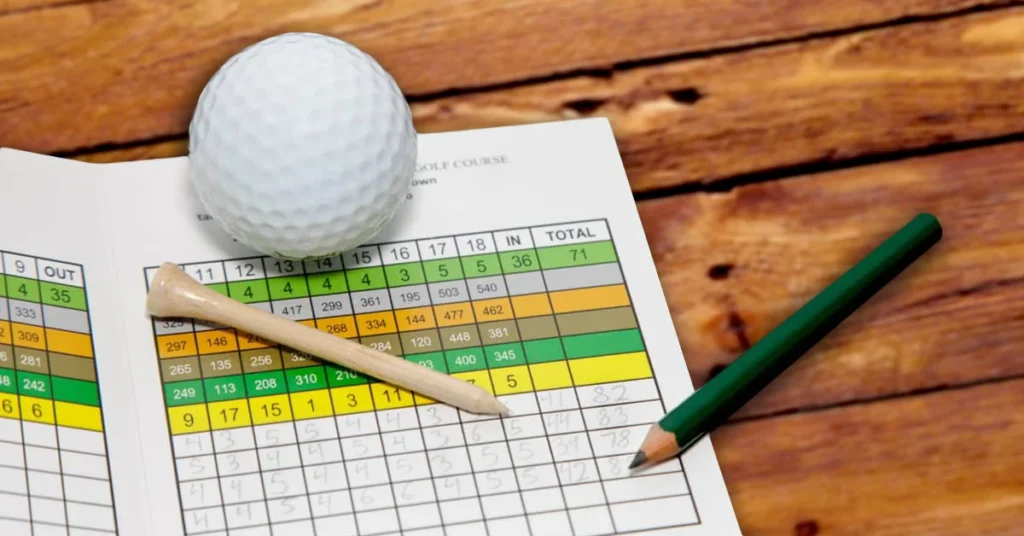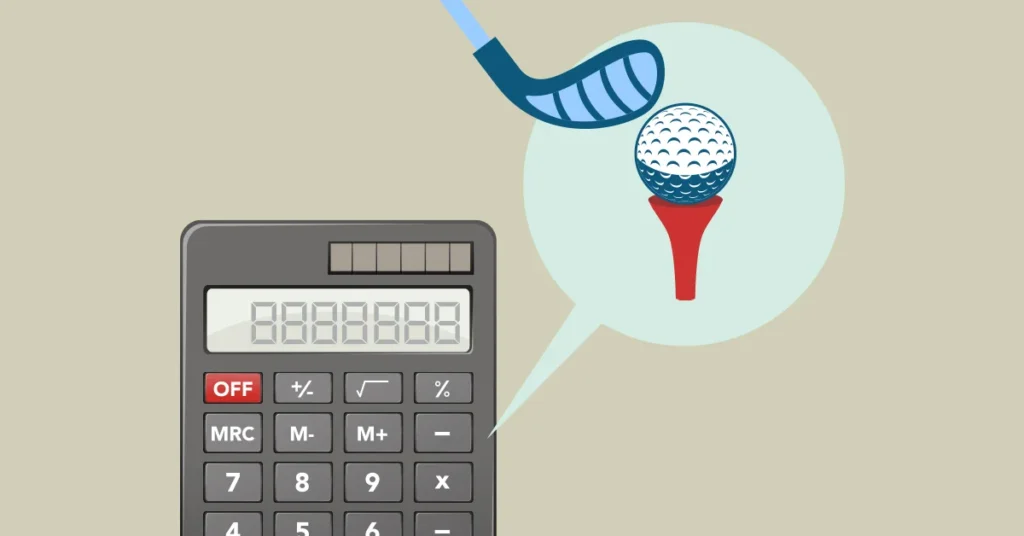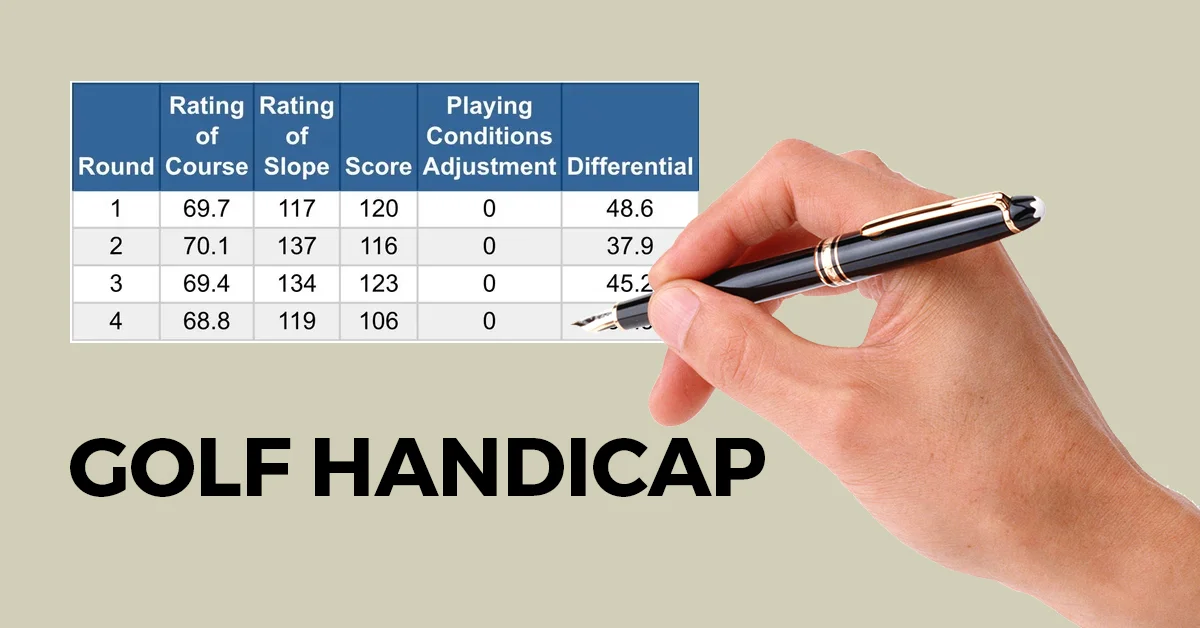- What is a Golf Handicap?
- Plus or Minus in Golf Handicaps
- What does your Golf Handicaps Mean?
- As an Example for Golf Handicaps
- The Difference Between a Golf Index and Golf Handicaps
- The Handicap Calculations
- How to Calculate Your Handicap in Golf:
- Expert Advice on Raising your Golf Handicap
- FINAL THOUGHTS
- Frequently Asked Questions
Your curiosity about the complexities of the golf handicaps system stems from your passion for the game. While many golfers are aware of their handicap, it is less common for them to fully comprehend how it is determined—the specifics of indexes and course handicaps.
We know that, despite the system’s apparent complexity, it is unquestionably something that can be understood with some understanding. Have you ever wondered what makes a golf handicap positive or negative? Within the bounds of fair play, we will together explore these ideas and offer some helpful advice on how to reduce your handicap.
What is a Golf Handicap?
In essence, a golfer’s handicap is a number that represents their ability to play the game. It functions similarly to a score that indicates a player’s level of skill. It means everyone has their own definition of what constitutes a “good” golf score. Golf handicaps, on the other hand, help put that straight by enabling players of various ability levels to compete fairly against one another.
Golf handicaps are not a very new idea. The Prestwick Golf Club in Scotland created what is arguably the first handicap system back in 1851. It was very simple, like giving someone an advantage in a race.
Golfers were allotted a certain number of strokes per round based on their prior scores, their own assessment of their own skill, and the opinions of others. Although it was not flawless, it was a good start. The World Handicap System was introduced in 2020, which brought about a significant change.
For the benefit of golfers everywhere, this system combined the handicapping procedures of the R&A and the USGA (United States Golf Association).
Plus or Minus in Golf Handicaps
Although the idea of a plus (or sometimes minus) handicap in golf can be a little confusing at first, it is important to comprehend player skill levels and handicapping.
Plus Handicap Golfers:
- A plus handicap golfer is one who normally shoots lower than par. This suggests that their skill level exceeds the average benchmark set by a par score.
- The handicap system uses a ‘+’ sign to indicate this. A golfer with a handicap index of +4, for example, would typically be four strokes under par.
Minus Handicap Terminology:
- Although less common and technically incorrect, the term ‘minus handicap’ is sometimes used informally. This is because handicaps are typically perceived as extra strokes awarded to a player.
- A golfer receives additional strokes to level the playing field for regular (non-plus) handicaps based on their handicap. A plus handicap golfer, on the other hand, “loses” strokes due to their higher skill level.
- Because these golfers are deducting strokes from their score in handicap-adjusted rounds, the term “minus” may be used informally.
In a net Tournament, for Instance:
- A golfer with a +4 handicap would see a stroke increase in gross score in a tournament setting where net scores are used.
- When a golfer with a +4 handicap, for instance, shoots a gross score of 75, their net score is changed to 79 (75 plus the 4 strokes that come with having a plus handicap).
Appropriate Terminology:
- More specifically, players who score higher than par are officially called plus handicappers under the World Handicap System. For the sake of clarity, it is important to use this terminology, particularly in official golf competitions and settings.
What does your Golf Handicaps Mean?
Your golf handicap, which indicates to the world how many strokes over par you usually shoot in a round of golf, is similar to a personal scorecard. A golfer with a 10-handicap would typically be shooting around 82 because most courses have a par of 72.
Below is a brief explanation of the various golf handicaps indexes and their corresponding golfer types:
- +2 to 8: You are a 70-year-old golfer, also referred to as a single-digit player. Based on your consistent 70-score, it appears that you possess a fair amount of skill.
- 9–18: You are a golfer from the 1980s. Your scores usually hover in the 80s range.
- 19–28: Greetings from the 90s club. Your scores are typically in the 90s.
- 29 and up: You are shooting over 100 and in the 100+ zone.
- But keep in mind that a handicap does not guarantee how well you will play each and every time you tee off. Have you ever talked to a 10-handicapper about their 90-shot streak? While uncommon, it does occur. Golf can be unpredictable like that.
The golf handicap system is incredibly inclusive, which is one of its best features. It provides for fair competition between players of all skill levels. Consider a match between a player with a zero handicap (scratch) and a player with a 20 handicap.
They can have a fair and thrilling match because of the way handicap allowances are implemented. It is the equivalent of the golf community saying, “Anyone is welcome to play, regardless of skill level!”
As an Example for Golf Handicaps

For a better imaginary understanding, dive in this example to understand a golf handicaps.
Imagine there are two players on a par-72 golf course: Mark and Jeff. With a course handicap of 19, Mark is less skilled than Jeff, who is more skilled with a course handicap of 5.
They each play their turn now. We take a closer look at their final scores than just their raw scores. Rather, we modify these scores according to their handicaps. The handicap system’s ability to level the playing field for golfers of varying skill levels is evident here.
Suppose Jeff scores 79 and Mark scores 90. The handicaps are deducted from the gross scores to obtain the players’ net scores. Mark’s net score is therefore 71, which is calculated as follows: 90 is his total strokes, minus 19 is his handicap. Jeff’s net score is 74, which is equal to 79 minus 5.
Despite having initially shot more strokes than Jeff, Mark, with his net score of 71, actually prevails when we compare these net scores. This is due to the fact that the handicap system, which takes into consideration the players’ varying skill levels, makes the match more fair and competitive.
That is what makes golf such a welcoming and fun sport—it is like giving everyone an equal chance to win, no matter how good they are.
The Difference Between a Golf Index and Golf Handicaps
Understanding the difference between a golf index and a handicap score is important to playing golf with unity.
Golf Handicaps Index:
- You are assigned a Golf Handicap Index upon registering with the United States Golf Association (USGA). Your past performance is what determines how good you are as a player in this index.
- As you submit new scores, the dynamic index value is updated. It is determined via a formula that accounts for the difficulty of the courses you have played as well as your most recent golf outings.
Golf Course Handicap:
- You can then determine your course handicap for each individual course you play by using your golf handicap index.
- The slope and rating of the course are taken into account in this computation, which is specific to it. The course rating indicates the expected score for a scratch golfer, while the slope rating indicates the difficulty level for an average golfer.
- For instance, if you are playing on a challenging course and your handicap index is 15.2, your course handicap may be changed to 17. This indicates that, because of the difficulties of the course, you receive a few extra strokes than usual.
- On the other hand, your course handicap may be lowered to 14 if you are playing on a less challenging course, which reflects the decreased difficulty.
- Your Course Handicap is essentially a customized version of your Golf Handicap Index that accounts for the particular difficulties of each course. Your golf handicap Index serves as a broad gauge of your skill level. Regardless of the course, this method guarantees equity and gives players of all skill levels the opportunity to compete on an even playing field.
The Handicap Calculations
Here, we simplified the somewhat complex process that the World Handicap System (WHS) uses to calculate a golfer’s handicap for you to understand.
Calculating the Handicap Differential:
- We examine every one of a player’s previous twenty rounds.
- The following formula is used to determine the handicap differential:
- AGS incorporates modifications such as the net double bogey.
- The expected score (CR) for a scratch golfer on a particular course is a number that usually falls between 67 and 77.
- PCC adapts to variables like changing course configurations and weather.
- The slope rating, which ranges from 55 to 155, indicates how challenging the course is for bogey players.
Calculating the Handicap Index:
- The average of the top eight handicap differentials over the previous 20 rounds is then used to determine the handicap index.
- An extra correction is applied to this mean.
Course Handicap Calculation:
- The course handicap is determined for each individual course a golfer plays using the handicap index.
- The equation that is applied is:
- In this case, CR and Par indicate the course that is being played.
- Course rating is represented by the letter CR.
- Par refers to the golf course’s par.
- At the conclusion of a round, a golfer’s gross score is converted to their net score using this course handicap.
Although this explanation oversimplifies the procedure, it conveys the general idea of how the WHS determines a player’s handicap. Every day, when new scores are entered into the system, it updates to reflect the most recent and dynamic representation of a golfer’s skill.
No matter the course or circumstances, this is essential to maintaining fairness and competition in the sport.
How to Calculate Your Handicap in Golf:

Although it can be a little complicated, calculating your golf handicap is an important skill for any player. Although you can figure it out on your own, using the official golf handicap system of the USGA is the most accurate and best method.
When posting scores, this system takes into account a number of subtleties that can be difficult to monitor manually. Here’s a basic explanation of how to figure out your golf handicap:
Start by reviewing the course details and your score:
Examine your score and the details of the course you played.
Determine the Difference in Score:
- Use this formula:
(113/Slope Rating)× (Adjusted Gross Score–Course Rating)
- A net double bogey adjustment is factored in by the “Adjusted Gross Score.” For example, if Player A, who has a handicap of 7, makes a 9 on a par-4 where they have one shot, the hole’s net double bogey is 7. This is your adjusted score for the hole.
Check If Your Score Is Exceptionally Low:
- If your score is 7 strokes or lower than your current index for that day, it affects your scoring record.
- All scores used to calculate your index are affected if you are seven to ten strokes below your current index, or if you are more than ten strokes below. These scores are classified as exceptional.
Subtract from Exceptional Scores:
- If a player is more than ten strokes below the index, all scores are docked by two.
- A -1 deduction is made in the range of 7–10 strokes below.
Add the Score Differential and Adjust the Handicap Index:
- This differential should be added to your record after any exceptional scores have been calculated and adjusted for.
- The process is made simpler by the USGA GHIN handicap system. Your handicap index is automatically updated by the system when you log in and submit your rounds.
Although you can determine your handicap on your own, the USGA system guarantees accuracy and accounts for all required adjustments, making it a dependable option for serious golfers.
Expert Advice on Raising your Golf Handicap
Increasing your golf handicap can be a fulfilling endeavor. The following expert advice will help you improve and reduce that number:
Prioritize One Thing at a Time:
It can be daunting to try to change your entire game at once. Rather, pinpoint your game’s weakest point and focus on strengthening it initially. Focusing on one area of your game, such as your iron play, driving, or putting, enables more targeted and efficient improvement.
Activate the Strokes Gained App:
For a golfer, technology can be their best friend. Applications that monitor “strokes gained” can tell you a lot about where you are losing shots. You can improve the effectiveness of your practice sessions by using this data-driven approach to identify the areas of your game that require the most improvement.
Challenge Yourself with Tougher Courses:
Playing on more challenging golf courses can surprisingly help improve your game. More challenging classes can help you improve your skills because they make you adapt and think more strategically. As you gain experience navigating increasingly intricate layouts, you may even discover that your handicap decreases.
Make Use of the Proper Equipment
Your game can be significantly improved with the right equipment. Ensure that the clubs you own fit your playing style and ability level. This covers everything, from the proper shaft flex to the ideal club length and grip size. You can improve your performance and have more fun in the game with properly fitted equipment.
Keep in mind that raising your golf handicap is a journey. It calls for perseverance, repetition, and an openness to learning and change. You can significantly reduce your handicap and increase your enjoyment of the game of golf by concentrating on one thing at a time, making the most of technology, setting personal challenges for yourself, and making sure you have the necessary equipment.
FINAL THOUGHTS
To summarise, consider your golf handicap as a important measure of your ability, closely associated with your score compared to par. To put it simply, your chances of shooting more strokes over par in a round increase with your handicap.
Yes, you could make an educated guess at a “handicap” by using your past performance and scores, but this would only be an estimate. You must join a golf club that is authorized to issue handicaps in order to receive an official handicap, also known as a handicap index. This club is required to follow the guidelines of an official handicapping system, such as the World Handicap System (WHS).
If you take the game seriously, knowing and obtaining your golf handicap is essential. It is more than just a figure; it symbolizes your golfing accomplishments, struggles, and growth.
Naturally, reducing that number will ultimately improve your performance and lower your scores. Consider it a journey where every stroke you save will bring you one step closer to improving your game.
Frequently Asked Questions
Can My golf handicaps Change, and How Often?
You can adjust your golf handicap, yes. It is a dynamic figure that changes according to your most recent golf outings. Your handicap index can be updated daily under the World Handicap System to reflect your most recent scores and make sure it appropriately reflects your current playing ability.
what is a handicap on each hole?
The number of strokes a player can subtract from their actual score on a given hole based on their overall handicap is known as their handicap on that particular hole. It is employed to level the playing field during a match by adjusting the golfer’s score.
can you have a handicap lower than 0?
It is true that a golfer with a plus handicap (+1, +2, etc.) can have a handicap less than 0.
what is the lowest number of handicap in golf?
In golf, the lowest possible handicap is +10. This golfer consistently performs much better than scratch, as indicated by their plus handicap.
what is a minus handicap in golf?
Golfers who normally shoot below par are referred to as having a minus handicap, which is also called a plus handicap. A golfer with a handicap of +3, for instance, should typically shoot three strokes above par. Informal terminology such as “minus handicap” suggests that these proficient players’ handicap-adjusted scoring is reduced by strokes.
what is a scratch golfer?
A player who can play all rated golf courses to a Course Handicap of zero is known as a scratch golfer. A scratch player is essentially expected to play at least as well as the average player on the course, which indicates a high degree of skill.


